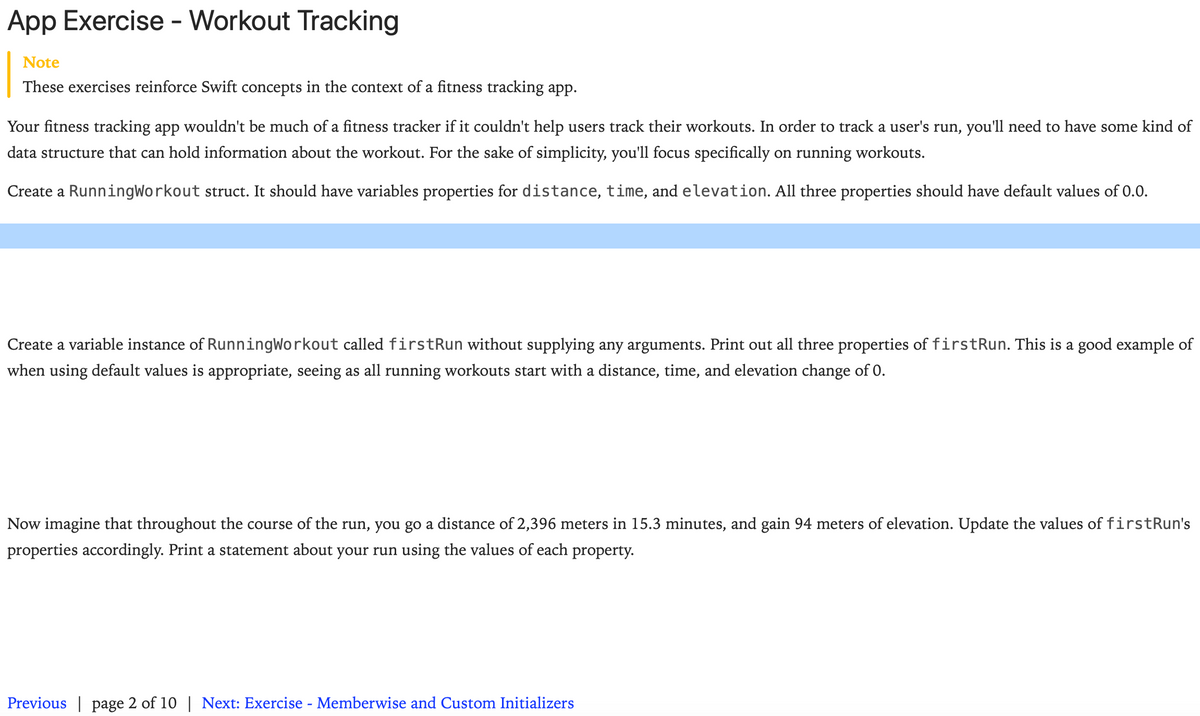App Exercise - Workout Tracking Note These exercises reinforce Swift concepts in the context of a fitness tracking app. Your fitness tracking app wouldn't be much of a fitness tracker if it couldn't help users track their workouts. In order to track a user's run, you'll need to have some kind of data structure that can hold information about the workout. For the sake of simplicity, you'll focus specifically on running workouts. Create a RunningWorkout struct. It should have variables properties for distance, time, and elevation. All three properties should have default values of 0.0. Create a variable instance of RunningWorkout called firstRun without supplying any arguments. Print out all three properties of firstRun. This is a good example of when using default values is appropriate, seeing as all running workouts start with a distance, time, and elevation change of 0. Now imagine that throughout the course of the run, you go a distance of 2,396 meters in 15.3 minutes, and gain 94 meters of elevation. Update the values of firstRun's properties accordingly. Print a statement about your run using the values of each property.
App Exercise - Workout Tracking Note These exercises reinforce Swift concepts in the context of a fitness tracking app. Your fitness tracking app wouldn't be much of a fitness tracker if it couldn't help users track their workouts. In order to track a user's run, you'll need to have some kind of data structure that can hold information about the workout. For the sake of simplicity, you'll focus specifically on running workouts. Create a RunningWorkout struct. It should have variables properties for distance, time, and elevation. All three properties should have default values of 0.0. Create a variable instance of RunningWorkout called firstRun without supplying any arguments. Print out all three properties of firstRun. This is a good example of when using default values is appropriate, seeing as all running workouts start with a distance, time, and elevation change of 0. Now imagine that throughout the course of the run, you go a distance of 2,396 meters in 15.3 minutes, and gain 94 meters of elevation. Update the values of firstRun's properties accordingly. Print a statement about your run using the values of each property.
Computer Networking: A Top-Down Approach (7th Edition)
7th Edition
ISBN:9780133594140
Author:James Kurose, Keith Ross
Publisher:James Kurose, Keith Ross
Chapter1: Computer Networks And The Internet
Section: Chapter Questions
Problem R1RQ: What is the difference between a host and an end system? List several different types of end...
Related questions
Question
How do I solve this using Swift code? 2 of 10

Transcribed Image Text:App Exercise - Workout Tracking
Note
These exercises reinforce Swift concepts in the context of a fitness tracking app.
Your fitness tracking app wouldn't be much of a fitness tracker if it couldn't help users track their workouts. In order to track a user's run, you'll need to have some kind of
data structure that can hold information about the workout. For the sake of simplicity, you'll focus specifically on running workouts.
Create a RunningWorkout struct. It should have variables properties for distance, time, and elevation. All three properties should have default values of 0.0.
Create a variable instance of RunningWorkout called firstRun without supplying any arguments. Print out all three properties of firstRun. This is a good example of
when using default values is appropriate, seeing as all running workouts start with a distance, time, and elevation change of 0.
Now imagine that throughout the course of the run, you go a distance of 2,396 meters in 15.3 minutes, and gain 94 meters of elevation. Update the values of firstRun's
properties accordingly. Print a statement about your run using the values of each property.
Previous | page 2 of 10 | Next: Exercise - Memberwise and Custom Initializers
Expert Solution
This question has been solved!
Explore an expertly crafted, step-by-step solution for a thorough understanding of key concepts.
This is a popular solution!
Trending now
This is a popular solution!
Step by step
Solved in 3 steps with 4 images

Recommended textbooks for you

Computer Networking: A Top-Down Approach (7th Edi…
Computer Engineering
ISBN:
9780133594140
Author:
James Kurose, Keith Ross
Publisher:
PEARSON

Computer Organization and Design MIPS Edition, Fi…
Computer Engineering
ISBN:
9780124077263
Author:
David A. Patterson, John L. Hennessy
Publisher:
Elsevier Science

Network+ Guide to Networks (MindTap Course List)
Computer Engineering
ISBN:
9781337569330
Author:
Jill West, Tamara Dean, Jean Andrews
Publisher:
Cengage Learning

Computer Networking: A Top-Down Approach (7th Edi…
Computer Engineering
ISBN:
9780133594140
Author:
James Kurose, Keith Ross
Publisher:
PEARSON

Computer Organization and Design MIPS Edition, Fi…
Computer Engineering
ISBN:
9780124077263
Author:
David A. Patterson, John L. Hennessy
Publisher:
Elsevier Science

Network+ Guide to Networks (MindTap Course List)
Computer Engineering
ISBN:
9781337569330
Author:
Jill West, Tamara Dean, Jean Andrews
Publisher:
Cengage Learning

Concepts of Database Management
Computer Engineering
ISBN:
9781337093422
Author:
Joy L. Starks, Philip J. Pratt, Mary Z. Last
Publisher:
Cengage Learning

Prelude to Programming
Computer Engineering
ISBN:
9780133750423
Author:
VENIT, Stewart
Publisher:
Pearson Education

Sc Business Data Communications and Networking, T…
Computer Engineering
ISBN:
9781119368830
Author:
FITZGERALD
Publisher:
WILEY